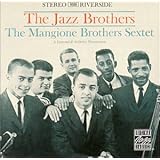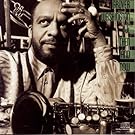First up was Grover Washington Jr. What I remember about him was first and foremost was that he was identified with the crossover movement to a more pop sounding jazz, not necessarily smooth jazz but rather an amalgam of rhythm and blues, pop, jazz, and soul. He tragically died while still in his prime at age 56 in 1999. As his contemporary sound became more popular, somehow it was as if jazz listeners wrote him off as too smooth, too polished, and too pop, overlooking his significant talent on multiple wind instruments and in particular his skills with the soprano sax. In fact, he came up out of strong jazz roots, trained first by his father, a jazz saxophonist himself, and later with Charles Earland as a sideman on Prestige. He was hardly soft, and his CD "Then and Now" (Columbia 1988) makes that abundantly clear. This is a straight-ahead set of eight songs played with a crackerjack set of sidemen -- either Tommy Flanagan or Herbie Hancock on piano; Russian Igor Butman on tenor sax; Grady Tate, Miguel Fuentes or Marvin "Smitty" Smith on drums; Gerald Veasley on bass; and Richard Steaker on guitar. Hancock burns on "Blues for D.P." a Ron Carter tune, while Flanagan is elegant on "In a Sentimental Mood" accompanying a wonderful Washington on alto. Elsewhere Washington is lovely on the tenor, particularly on "Lullaby for Shana Bly", his own composition, and as always plays a strong soprano on three tunes including "Stella by Starlight." It's a nice straight-ahead jazz set by a group of very talented musicians. First rate.
 Next, I was curious about the career of Chuck Mangione, whose big hit "Feels So Good" was ubiquitous in the mid-80s on jazz and pop radio, and who was generally categorized as a lightweight player of melodic, upbeat, and simplistic compositions; another in the line of crossover jazz-pop stars who opened the door for smooth jazz. First off, I happen to have liked Mangione's music, which was easy to listen to and enjoy. At the time I hardly considered whether it was or was not jazz, or whether it was a sellout to popular music. Today I still like the music, but I was curious about Mangione's background and his roots in jazz. What I found was interesting. He and brother Gap, a keyboard player, were trained at the Eastman school in Rochester and began their careers strongly in the bop tradition, fronting a quintet called the Jazz Brothers; and Mangione played in the Art Blakey band from 1965-67 as well as the big bands earlier of Woody Herman and Maynard Ferguson. There are CDs still available that demonstrate the skills of the brothers in the world of bop and post bop, notably their first recording under Cannonball Adderley's Riverside label, "The Jazz Brothers" (Riverside 1960) which is still available on the OJC label. The sextet in this case was Chuck Mangione on trumpet, Gap Mangione on piano, Larry Combs on alto sax, Sal Nistico on tenor sax, Bill Saunders on bass, and Ron McCurdy on drums. This is a first class, standard recording for it's day, six youngsters going on to big things. McCurdy would go on to Adderley's quintet and Nistico to Woody Herman's Herd and then to a fine but shortened career as a leader. Mangione's trumpet is clear and controlled, Gap's piano playing fluid, but it is Nistico whose sound really stands out and shapes the music along side Chuck. Most of the music was written by band members, with the standard "Secret Love" by Sammy Fain included in the set. this is very solid stuff, and Mangione and his band went on to produce several more mainstream recordings between 1960 and 1962, after which Chuck played for a while as a sideman in the aforementioned bands before returning as a leader with the softer sound of a flugelhorn and his new direction in music that kicked into high gear in the early 1970s with "Feels So Good." So did he sell out to commercialism moving with the times from jazz to pop? It really doesn't matter, does it, as he has left a fine set of music for both tastes.
Next, I was curious about the career of Chuck Mangione, whose big hit "Feels So Good" was ubiquitous in the mid-80s on jazz and pop radio, and who was generally categorized as a lightweight player of melodic, upbeat, and simplistic compositions; another in the line of crossover jazz-pop stars who opened the door for smooth jazz. First off, I happen to have liked Mangione's music, which was easy to listen to and enjoy. At the time I hardly considered whether it was or was not jazz, or whether it was a sellout to popular music. Today I still like the music, but I was curious about Mangione's background and his roots in jazz. What I found was interesting. He and brother Gap, a keyboard player, were trained at the Eastman school in Rochester and began their careers strongly in the bop tradition, fronting a quintet called the Jazz Brothers; and Mangione played in the Art Blakey band from 1965-67 as well as the big bands earlier of Woody Herman and Maynard Ferguson. There are CDs still available that demonstrate the skills of the brothers in the world of bop and post bop, notably their first recording under Cannonball Adderley's Riverside label, "The Jazz Brothers" (Riverside 1960) which is still available on the OJC label. The sextet in this case was Chuck Mangione on trumpet, Gap Mangione on piano, Larry Combs on alto sax, Sal Nistico on tenor sax, Bill Saunders on bass, and Ron McCurdy on drums. This is a first class, standard recording for it's day, six youngsters going on to big things. McCurdy would go on to Adderley's quintet and Nistico to Woody Herman's Herd and then to a fine but shortened career as a leader. Mangione's trumpet is clear and controlled, Gap's piano playing fluid, but it is Nistico whose sound really stands out and shapes the music along side Chuck. Most of the music was written by band members, with the standard "Secret Love" by Sammy Fain included in the set. this is very solid stuff, and Mangione and his band went on to produce several more mainstream recordings between 1960 and 1962, after which Chuck played for a while as a sideman in the aforementioned bands before returning as a leader with the softer sound of a flugelhorn and his new direction in music that kicked into high gear in the early 1970s with "Feels So Good." So did he sell out to commercialism moving with the times from jazz to pop? It really doesn't matter, does it, as he has left a fine set of music for both tastes. And finally a word about Sal Nistico, a very talented tenor sax player whose career tragically ended at age 53, and whose recordings are largely ignored today. Nistico was a member of some great bands, beginning with the Mangione's in the early 60s and then with Woody Herman's Herd and Count Basie's band in the 60s and 70s. He also freelanced with players such as Don Ellis and Buddy Rich, and was a leader on several occasions with his own bands. "Heavyweights" (Jazzland 1961) was his first recording as a leader, and is combined with his second, "Comin' On Up" (Riverside 1962) on a CD released on Milestone in 2002 simply called "Heavyweights" with all 13 songs from both sets. On the first set he recorded with Nat Adderley on cornet, Barry Harris on piano, Sam Jones on bass, and Walter Perkins on drums, a crew largely from the Cannonball Adderley band. On the second set it is Sal Amico on trumpet, Barry Harris on piano, Bob Cranshaw, on bass, and Vinnie Ruggiero on drums. If you are known by the company you keep, then Nistico was clearly a fine musician, which is borne out by the music. Hot stuff worth finding.
And finally a word about Sal Nistico, a very talented tenor sax player whose career tragically ended at age 53, and whose recordings are largely ignored today. Nistico was a member of some great bands, beginning with the Mangione's in the early 60s and then with Woody Herman's Herd and Count Basie's band in the 60s and 70s. He also freelanced with players such as Don Ellis and Buddy Rich, and was a leader on several occasions with his own bands. "Heavyweights" (Jazzland 1961) was his first recording as a leader, and is combined with his second, "Comin' On Up" (Riverside 1962) on a CD released on Milestone in 2002 simply called "Heavyweights" with all 13 songs from both sets. On the first set he recorded with Nat Adderley on cornet, Barry Harris on piano, Sam Jones on bass, and Walter Perkins on drums, a crew largely from the Cannonball Adderley band. On the second set it is Sal Amico on trumpet, Barry Harris on piano, Bob Cranshaw, on bass, and Vinnie Ruggiero on drums. If you are known by the company you keep, then Nistico was clearly a fine musician, which is borne out by the music. Hot stuff worth finding.It's pretty interesting and enlightening strolling through the past, and it produces some nice music and a better understanding of the players who have shaped jazz tastes through the decades. Other times I have written about forgotten players from the 50s or 60s, this time it's about under-appreciated talents from the 70s and 80s whose record has been dulled by general antipathy towards their popular recordings. Always intriguing pouring over the histories.

No comments:
Post a Comment